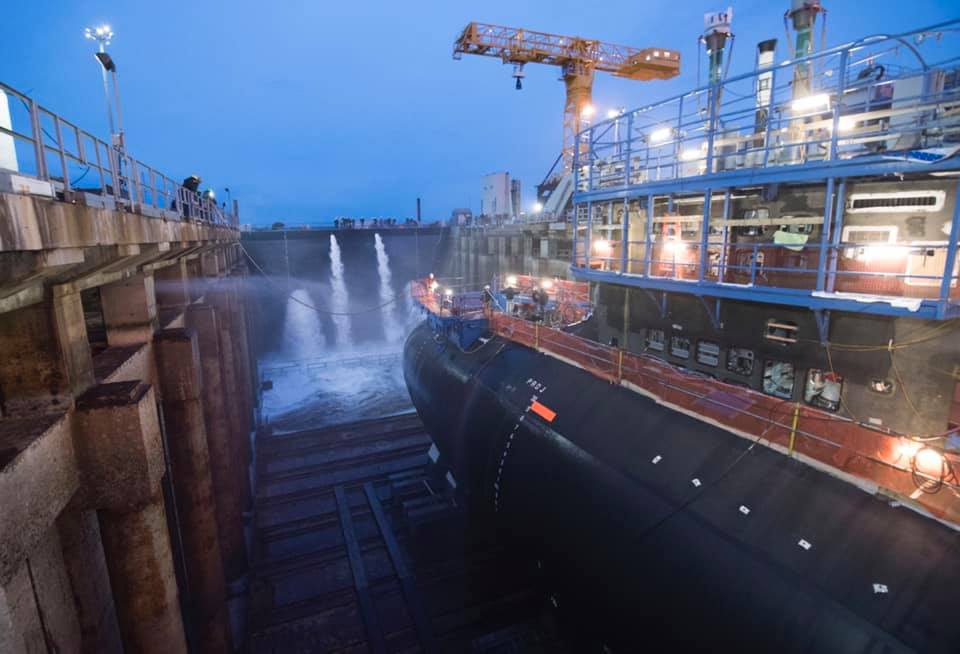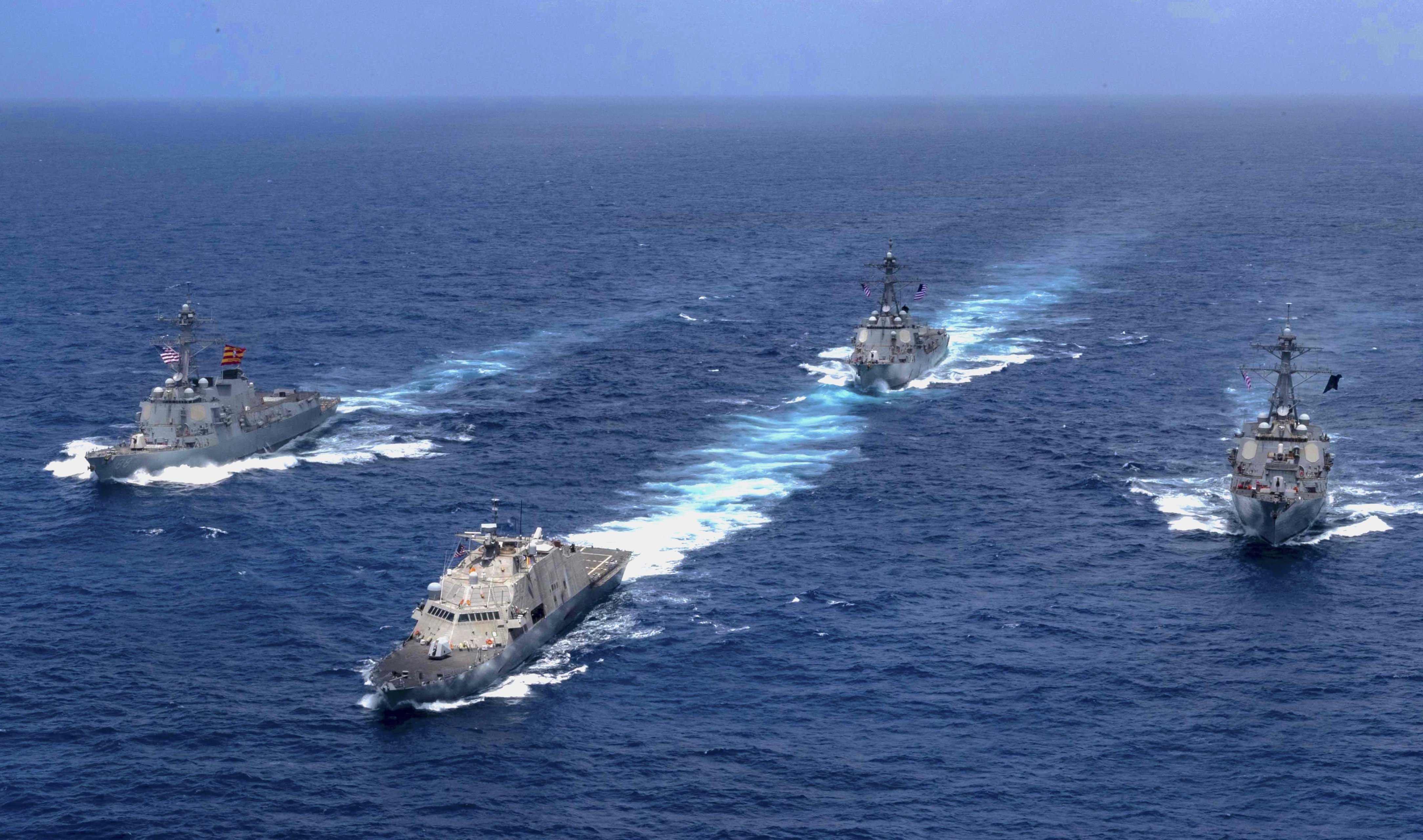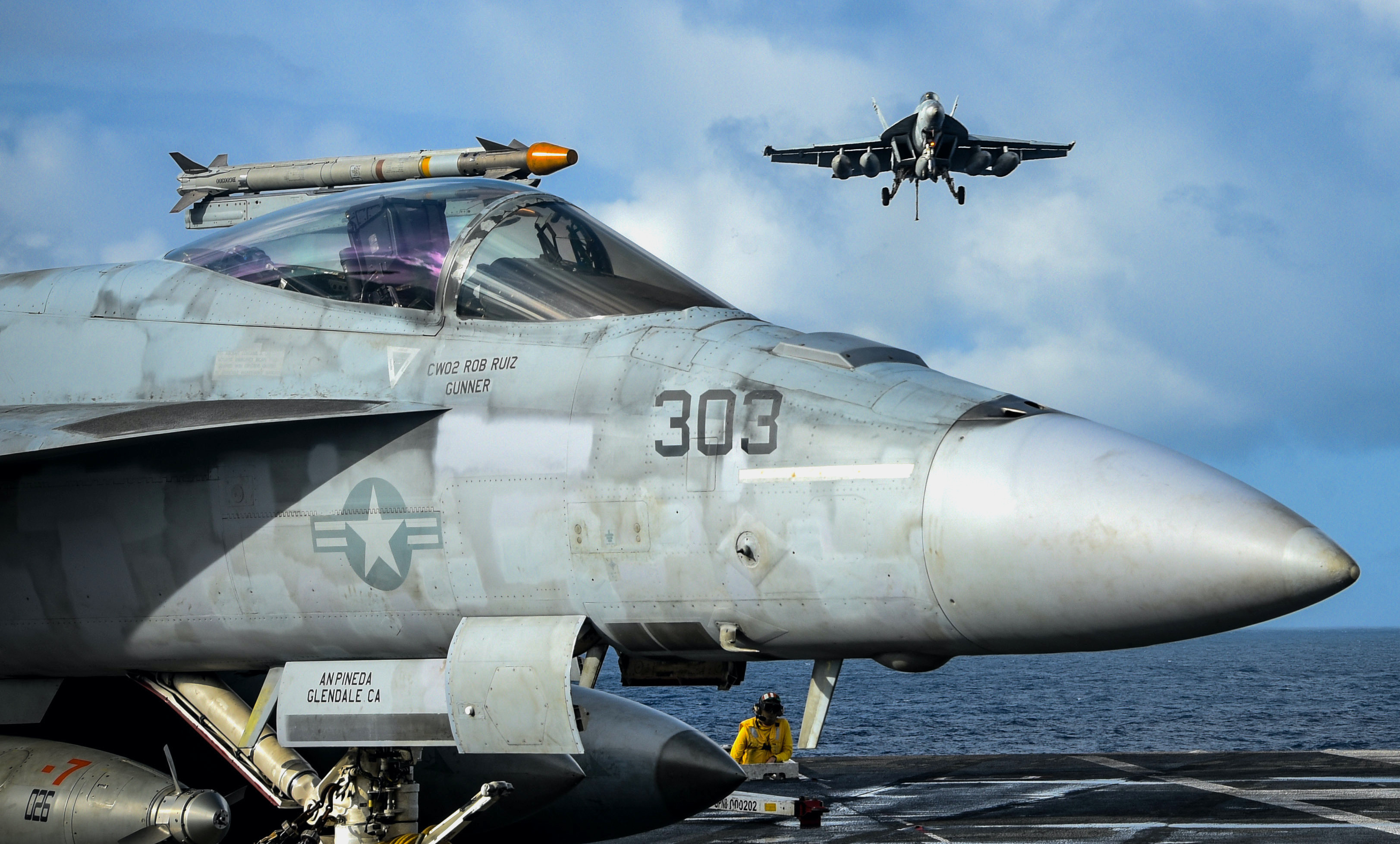
This post is part of a series of stories looking back at the top naval news from 2020.
2020 may be among the most consequential years for Navy acquisition in recent memory, with the service making big moves in support of its Distributed Maritime Operations operating concept.
2020 was the year the Navy officially started construction on the Columbia-class ballistic missile submarine program, a massive every-other-generation effort to replace the sea-based nuclear deterrent subs. It was also the year the Constellation-class guided-missile frigate program was awarded to Fincantieri, who will design and build what will become a centerpiece of the future distributed fleet. It was the year the Navy called for an end to the F/A-18E-F Super Hornet program, reinvesting that money into a longer-range next-generation fighter that could help silence critics who say the aircraft carrier will be useless against China because the air wing’s range is too short. And it was the year the Navy and its Marine Corps partners moved out on a Light Amphibious Warship that could revolutionize how the Fleet Marine Force moves around a maritime theater in support of sea control and sea denial.
Surface Ships

The surface fleet is among the parts of the Navy most changed by Distributed Maritime Operations. Rather than the Navy’s recent reliance on guided-missile cruisers and destroyers to drill with allies and partners, patrol chokepoints and conduct freedom of navigation operations, the Navy will instead rely on a large fleet of small combatants to do much of this day-to-day work, freeing up a smaller number of destroyers to conduct higher-end operations and haul around large, long-range missiles.
Key to this plan is the success of the Constellation-class frigate.
The Navy awarded a $795-million contract to Fincantieri on April 30 to do detail design work and build the first frigate in the class. Options for as many as nine more ships would bring the total value to $5.58 billion if exercised.
Fincantieri beat out four other competitors with a design based on the FREMM multi-mission frigate already operated by the French and Italian navies. It will build the frigate at its Marinette Marine shipyard in Wisconsin.
In October, the class officially received a name, with Navy Secretary Kenneth Braithwaite announcing the first-in-class ship would be USS Constellation (FFG-62) – after it was nearly named USS Agility by former SECNAV Thomas Modly earlier in the year.
Though there will be fewer large combatants in the fleet, their mission will remain important: Navy leadership has said the large combatants of the future will haul around the biggest missiles, including hypersonic weapons.

The Navy is still struggling to figure out how to get the ship it needs for a price it can afford, given the deemphasis on the large combatant portfolio in future fleet plans. What was once a 2023 start to the Large Surface Combatant program was pushed to 2025 and then 2026 – and this year, Chief of Naval Operations Adm. Mike Gilday said the large combatant, which he calls “DDG-Next,” will begin detail design in 2026 and construction in 2028.
New and important to the DMO concept – and the related Marine Corps concepts of Littoral Operations in a Contested Environment (LOCE) and Expeditionary Advance Base Operations (EABO) – are the Light Amphibious Warship (LAW) and the Next-Generation Logistics Ship (NGLS) programs that kicked off this year.
After some Marine Corps officials had kicked around the idea of a stern-landing vessel for EABO operations last year, in February the Navy included in its Fiscal Year 2021 budget request $30 million each to begin working on the new amphib and new logistics ship.

Throughout the summer, the vision of what LAW would become grew clearer, as the Marines made the case for small units operating outside the Amphibious Ready Group/Marine Expeditionary Unit construct. These units would move from shore to shore, providing the joint force forward refueling and rearming capabilities in remote locations, collecting intelligence, providing anti-ship and even anti-submarine strike capabilities, and more. Their small footprint and maneuverability with the LAWs would make them hard for an adversary to detect and hit. By the fall, a cost estimate of about $100 million apiece, as well as requirements for length, storage capacity, crewing and more emerged, showing the dedication to begin buying the ships in FY 2022.
According to the long-range shipbuilding plan that accompanied the release of Battle Force 2045, the Next-Generation Logistics Ship would kick off procurement in FY 2023, though much less is known about that new ship compared to the LAW. This medium-sized ship would be able to help resupply the distributed Navy and Marine forces operating under DMO and EABO, while blending in with local merchant traffic and being harder for an adversary to target and disrupt the flow of supplies into theater. It’s unclear how far along the Navy is in developing its requirements. A previous effort for a somewhat larger set of ships to do resupply and other missions, called the Common Hull Auxiliary Multi-mission Platform (CHAMP), has hit several roadblocks as its price tag remains higher than Navy and White House officials are comfortable spending on an auxiliary ship.
Submarines

The Navy in November awarded $9.47 billion to General Dynamics Electric Boat to officially start construction on the first ballistic-missile submarine in the Columbia class. This SSBN program is the Navy’s all-important program with no room for error or delays, after all schedule margin was eaten up in the early days of the program and the future USS Columbia (SSBN-826) must be ready for its first patrol in the fall of 2030.
Despite the COVID-19 pandemic, the Columbia program remained on track, in a nod to the importance on the program and the Navy prioritizing resources – available workers, materials and money – to keeping this program on track, even if it means attack submarines or aircraft carriers slipping in schedule.
Still, though the program has remained on track, the Navy announced last month it was looking at extending the life of the legacy Ohio-class SSBNs – again – to provide a bit of additional capacity for combatant commanders and a bit of cushion in case there are hiccups in the future with the Columbia program.
Partly as a result of keeping Columbia on track, the Virginia-class attack submarines slipped further behind in production this year, after already having some schedule delays as the program tried to maintain a two-a-year production rate. Threatening to further challenge the program was a White House proposal to buy just one SSN in FY 2021, which would throw off the workflow for thousands of suppliers trying to smoothly ramp up their production rates to accommodate both the Virginia and the Columbia programs. The White House reversed course in late November and expressed support for a second Virginia sub.
Looking towards the future, the Navy this year made headway planning for its Block VI Virginia design – which would add new capability and lethality such as improved stealth and the ability to conduct seabed warfare – as well as the SSN(X) design that would build upon both Block VI and the Columbia SSBN design. All told, the Navy is trying to morph its attack submarine fleet to something closer to the Seawolf class, which was designed to operate deep into Soviet waters and go head-to-head with peer adversary subs, compared to the Virginia class which was originally designed for land-attack and intelligence-collection missions.
Carrier Aviation

Even as the Navy continued on with its Ford-class carriers this year, questions began swirling about the class’s future and what might come next to either replace or to supplement the Ford-class supercarrier.
In March, Modly kicked off a Blue-Ribbon Future Carrier 2030 Task Force to look at the future of aircraft carriers and whether the U.S. Navy would stick with the Ford class beyond the future Doris Miller (CVN-81), whether it would move to a different nuclear-powered carrier design, or whether it would use conventionally powered carriers. Despite the prominent figures on the task force, it was not particularly well received: any reduction in demand for nuclear ship components could break the fragile industrial base, some worried, while others were concerned that the 11-carrier fleet was already overworked today and that the task force could lead to a reduction in CVNs in the future without a reduction in demand for their presence in theater.
Though the study itself was canceled just two months later by Acting SECNAV James McPherson, the idea lingered: former Defense Secretary Mark Esper became interested in the notion of a conventionally powered light carrier to supplement the nuclear-powered supercarrier, and after months of study he settled on a plan to field eight to 11 CVNs – possibly down from today’s 11 – and supplement them with as many as six CVLs. He and Navy officials conceded that much work needed to be done to figure out what the CVL would look like and how to balance the two classes of ships.

Despite the questions about the future of carriers, the Ford-class program continued along, with USS Gerald R. Ford (CVN-78) at times spending more days at sea than in port to conduct post-delivery tests and trials and get ready for full-ship shock trials next summer. Despite PDT&T moving ahead of schedule and the troubled Advanced Weapons Elevators finally coming online in numbers, the Navy fired its CVN-78 program manager and brought in a captain with “proven program management acumen and extensive waterfront experience” to see Ford through its remaining work before being fully turned over to the fleet for a maiden deployment.
Aircraft

In a major move for carrier aviation, the Navy announced in February in its FY 2021 budget request that it would not continue Super Hornet production beyond the end of the current multiyear contract, which runs through FY 2021. Funding that had been planned for another contract for FY 2022 through 2024 would instead be diverted to “accelerated development of Next Generation Air Dominance (NGAD) and other key aviation wholeness investments.”
With little fanfare, the Navy stood up an NGAD program office under Naval Air Systems Command in May and quickly began industry talks.
Though investing in NGAD was the primary reason for ending the Super Hornet line, the Navy also said that stopping new Super Hornet production would free up the production line for Super Hornet life extension work, which the Navy needs to add capability to the jets and keep them around long enough for a replacement to be designed and built.

Supporting a near-term change for the carrier air wing, Bell-Boeing delivered the first CMV-22B Osprey to the Navy in February, allowing the Navy to start a short test and evaluation program before turning the aircraft over to the operational squadron that will support the first deployment in 2021. The Navy needs the CMV-22 to serve as its new carrier onboard delivery (COD) platform because the legacy C-2 Greyhound cannot carry a large F-35C engine; the Osprey could carry the engine out to an aircraft carrier and would also have the added flexibility of being able to bring people and supplies directly to the other ships in the strike group, which can support the V-22 landing on their helicopter decks. USS Carl Vinson (CVN-70) will make the first deployment with the F-35C in 2021, so the CMV-22 needs to be ready too for that deployment.
Looking a few years out, the Navy is making good progress on its MQ-25A Stingray unmanned carrier-based refueling tanker. In April the Navy exercised a contract option to buy three more aircraft from Boeing, and in December the Stingray made its first flight with the refueling system attached under its wings.
Unmanned Systems

In other unmanned news, the Navy set off down a path to design and build medium and large unmanned surface vessels of its own, after earlier work had been done with Pentagon-purchased USVs.
L3 Technologies in July won a $35-million contract to develop a prototype Medium Unmanned Surface Vehicle (MUSV), with options for eight follow-on craft that could bring the contract to a value of $281 million. In September, the Navy awarded six companies contracts to begin determining what the service’s Large Unmanned Surface Vehicle will look like. Austal USA, Huntington Ingalls Industries, Fincantieri Marinette, Bollinger Shipyards, Lockheed Martin and Gibbs & Cox each won about $7 million for LUSV design studies.
Using Pentagon-built prototypes, the Navy operated the Sea Hunter medium USV with a carrier strike group this year, and an Overlord large USV conducted the first-ever autonomous transit of the Panama Canal as it sailed from the Gulf of Mexico to Southern California.
In the undersea domain, just this week the Navy released its final request for proposals for the Snakehead Large Displacement Unmanned Underwater Vehicle (LDUUV) program, with the intention to select a single vendor next year to begin designing and building two prototypes.
Plans and Budgets

Though many of these moves in 2020 will be instrumental in creating the fleet the Navy and Marine Corps know they need to deter China or win a fight if needed – especially the unmanned vessels, the light amphib and the frigate – the exact future shipbuilding plans for the Navy are still unclear.
After the Navy and Marine Corps wrapped up an Integrated Naval Force Structure Assessment in January, Esper did not agree it was the right plan. He ultimately kicked off a Pentagon-led Future Naval Force Study that worked from February to October to look at what the sea services needed to do to be prepared to beat China in a fight in the 2045 timeframe. This effort led to a Battle Force 2045 plan that had all the same themes as the Navy’s original INFSA earlier in the year. The Pentagon couched the differences as a matter of timelines and how aggressively to begin making changes: The Navy had been focused on a 2030 timeframe and what needed to happen quickly to overhaul the fleet in the next decade to support DMO, LOCE and EABO. The Pentagon instead took a longer view meant to incorporate what kind of threat China could ultimately become in the long run and therefore what the Navy and Marines would need to do to counter it – with the expectation that transformation would start now with that 2045 threat in mind.
The plan will need buy-in from lawmakers, who have been largely unimpressed with the plans presented to them this year. The original FY 2021 budget request was called “dead on arrival” after it contained the smallest shipbuilding budget in years. The Battle Force 2045 and its accompanying long-range shipbuilding plan was panned for the opposite reason, for being out of touch with budget realities and calling for too quick a naval buildup.





